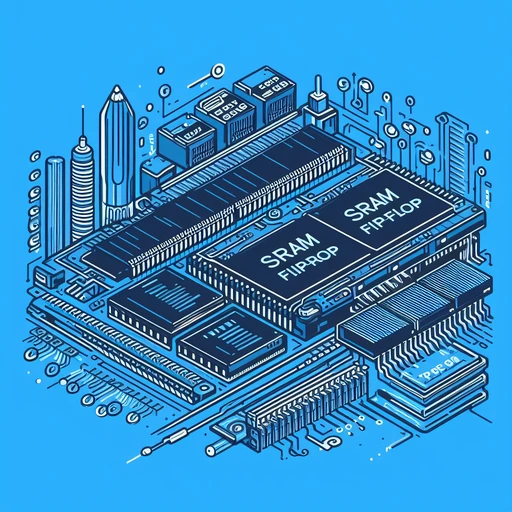In the dynamic world of artificial intelligence (AI), the ongoing pursuit of optimal performance and efficiency poses a constant challenge. At the core of AI systems lies a crucial component that plays a decisive role in determining their speed, reliability, and overall functionality – memory. Among the diverse array of memory technologies, Static Random-Access Memory (SRAM) has emerged as a significant player, holding considerable potential in shaping the future landscape of AI memories.
SRAM, known for its speed, volatility, and low power consumption, has become an essential element woven into the complex fabric of AI architectures. As AI applications continue to progress, with ever-increasing demands for heightened computational capabilities, the importance of memory cannot be emphasized enough. This article explores the realm of SRAM and its pivotal role in driving the next wave of AI innovations, shedding light on how this memory technology serves as a linchpin in the quest for efficient, high-performance AI systems.
Table of Contents
ToggleUnderstanding SRAM
Definition and Basics
Static Random-Access Memory (SRAM) stands as a crucial component within the family of computer memory technologies. Unlike its counterpart, Dynamic Random-Access Memory (DRAM), SRAM doesn’t require constant refreshing, making it faster and more energy-efficient. At its core, SRAM consists of flip-flop circuits, each storing a single bit of data. These circuits retain information as long as power is supplied, facilitating quick and direct access to stored data.
How SRAM Differs from Other Types of Memory
In the spectrum of memory technologies, SRAM’s characteristics distinguish it prominently from alternatives like DRAM. Unlike DRAM, SRAM doesn’t rely on the periodic refreshing of data, enabling faster access times. While DRAM is cost-effective for storing large amounts of data, SRAM excels in applications requiring rapid and constant access, such as cache memory in computing systems.
- Key Characteristics of SRAM
- Speed: SRAM’s access speed is notably faster compared to other memory types, making it well-suited for high-performance computing tasks in AI applications.
- Volatility: SRAM is volatile, meaning it loses its stored data when power is cut off. While this might be a limitation in certain contexts, its speed and efficiency often outweigh this drawback.
- Power Consumption: SRAM consumes relatively low power, contributing to energy efficiency in electronic devices. This characteristic becomes particularly significant as the demand for energy-efficient AI systems continues to rise.
The Crucial Role of Memory in AI
Unveiling the Landscape of Memory Types in AI Systems
In the expansive domain of artificial intelligence, memory stands as the bedrock for processing and managing vast troves of data. A variety of memory technologies assume distinct roles in AI systems, each catering to different facets of computation.
- RAM (Random-Access Memory): RAM serves as the dynamic workspace for active programs and data, ensuring swift access for computational tasks. Its significance lies in facilitating real-time processing and the efficient execution of algorithms.
- Storage Memory (e.g., SSDs, HDDs): Holding extensive datasets, storage memory facilitates the long-term storage and retrieval of information. Although not as rapid as RAM, storage memory plays a vital role in preserving data beyond the immediate scope of a computing session.
- Cache Memory: Positioned between RAM and the CPU, cache memory, often employing SRAM, strikes a balance between speed and capacity. This intermediary memory enables rapid access to frequently used data, optimizing the overall performance of AI systems.
Memory’s Pivotal Role in AI Tasks
- Training: Memory proves critical during the training phase of AI models, where vast datasets undergo processing to enhance the system’s learning capabilities. The efficiency of accessing and manipulating data in memory directly influences the speed of model training.
- Inference: In real-world applications, AI models must swiftly make predictions based on learned patterns. The indispensability of fast and responsive memory, such as SRAM, becomes apparent in ensuring timely and accurate responses during inference tasks.
- Data Storage: Given the colossal datasets handled by AI systems, efficient storage solutions are imperative. The choice of memory technology directly impacts the speed of data retrieval and the overall responsiveness of AI applications.
Navigating Challenges and Meeting Demands in Memory for Advanced AI Applications
As AI applications evolve into more sophisticated realms, the demands placed on memory systems grow more intense. High-dimensional data, intricate neural network architectures, and real-time processing requirements necessitate memory solutions capable of keeping pace with these evolving computational needs. The quest for faster, more efficient, and reliable memory technologies has never been more pressing.
We have written a whole descriptive article on AGI VS ANI ,do give it a read
SRAM’s Contribution to AI Memories
1)Speed and Efficiency in Memory Access
In the fast-paced world of AI computations, speed is paramount. SRAM’s inherent design allows for rapid and direct access to stored data, minimizing latency and significantly boosting processing speeds. This efficiency is particularly crucial for real-time applications and tasks requiring instant decision-making.
2)Low Power Consumption for Energy-Efficient AI Systems
SRAM’s low power consumption is a game-changer in the pursuit of energy-efficient AI systems. As compared to alternatives, SRAM’s ability to operate with minimal power not only contributes to longer battery life in portable devices but also aligns with the growing emphasis on sustainable and green computing practices.
3)Reliability and Durability for Prolonged Use
In the dynamic landscape of AI, where models and applications undergo continuous iterations, the reliability and durability of memory become paramount. SRAM’s robust design ensures stable performance over extended periods, making it a dependable choice for memory-intensive AI tasks, including training and inference.
Advancements and Innovations
Recent Developments in SRAM Technology
The realm of SRAM technology continues to witness noteworthy advancements. Miniaturization and process enhancements have led to the development of smaller, more efficient SRAM cells. This progress contributes to increased memory density, a critical factor for accommodating the expanding requirements of AI models.
1)Integration of SRAM with Emerging AI Architectures
As AI architectures evolve, the integration of SRAM becomes more intricate. Neuromorphic computing, in particular, benefits from SRAM’s speed and parallelism, mimicking the brain’s processing capabilities. The seamless synergy between SRAM and emerging architectures fosters the creation of more powerful and efficient AI systems.
2)Potential Future Advancements and Implications
Looking forward, the future holds promising possibilities for SRAM in AI. Advancements may focus on addressing current limitations, such as improving non-volatility and reducing power consumption even further. These developments could have profound implications for the scalability and efficiency of memory systems in next-generation AI applications.
Challenges and Solutions
1)Limitations of SRAM in AI Applications
Despite its advantages, SRAM comes with inherent challenges. Its volatility poses constraints in certain applications where non-volatile memory is preferred. Additionally, the trade-off between speed and density remains a consideration, as increasing memory density often leads to compromises in access speed.
2)Ongoing Research and Development
To overcome these challenges, ongoing research and development efforts are underway. Scientists and engineers are exploring novel approaches, including hybrid memory architectures and advanced materials, to enhance the non-volatile characteristics of SRAM. These endeavors aim to expand the applicability of SRAM in diverse AI scenarios and mitigate its limitations.
3)Exploration of Alternative Memory Technologies
The pursuit of optimal memory solutions for AI extends beyond SRAM. Researchers are actively exploring alternative memory technologies like Resistive RAM (ReRAM) and Magnetic RAM (MRAM). These alternatives offer unique characteristics, such as non-volatility and scalability, providing potential solutions to the challenges faced by traditional SRAM.
Wrapping It Up
In the complex dance of artificial intelligence and memory technologies, SRAM takes center stage as the key player for what lies ahead. As we journey through the different aspects of SRAM’s traits, contributions, and progress, a captivating story unfolds, painting SRAM as a crucial part in the evolution of AI memories.
The built-in speed and efficiency of SRAM’s design make it a must-have for real-time AI applications, where speedy data access is everything. Its low power consumption fits perfectly with the increasing push for energy-efficient computing, a critical factor for the sustainability of AI systems. Yet, the road isn’t all smooth, and ongoing research is tackling challenges, ensuring that SRAM remains a leader in memory technology.
Looking ahead, SRAM’s role in AI memories becomes even more prominent. Foreseen breakthroughs hold the key to improved non-volatility, scalability, and seamless integration with emerging architectures, reshaping the AI memory landscape. The path of AI memory systems, guided by SRAM’s evolution, points to a future where computational limits are pushed, and fresh applications redefine the norms.
To sum it up, SRAM isn’t just a memory technology; it’s a spark for innovation, efficiency, and resilience in the dynamic field of artificial intelligence. Its journey is interwoven with the very fabric of AI memories, propelling us toward a future where the seamless interplay between SRAM and advanced AI applications keeps unveiling new possibilities. Cheers to the exciting journey ahead! 🌟




